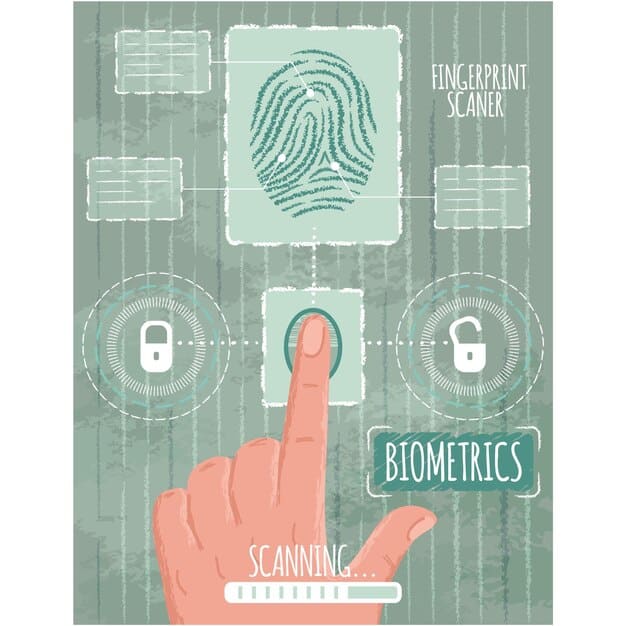Biometric Data Privacy: Risks of Fingerprint and Facial Recognition

Biometric data privacy is critical due to the increasing reliance on fingerprint and facial recognition technologies, which pose significant risks if data is compromised, including identity theft and privacy breaches, demanding robust security measures and user awareness.
In an era dominated by technological advancements, **biometric data privacy: understanding the risks of fingerprint and facial recognition** has become increasingly crucial. These technologies, once confined to science fiction, are now integral to our daily lives, from unlocking smartphones to streamlining border control. As we embrace these innovations, it’s essential to understand the potential privacy implications and the steps we can take to protect our sensitive information.
What is biometric data and how it is collected?
Biometric data refers to unique biological characteristics that can be used to identify individuals. This includes fingerprints, facial features, iris patterns, voiceprints, and even gait analysis. The collection of this data has become commonplace, often without our explicit awareness.
Fingerprint scanning, for instance, is now standard on smartphones and laptops, while facial recognition is used in security cameras, social media platforms, and even retail stores. Iris scans are employed in high-security environments, and voiceprints are often collected by virtual assistants and call centers. The ubiquity of these technologies means that our biometric data is constantly being gathered, stored, and analyzed.
Common methods of biometric data collection
Understanding the various methods through which biometric data is collected is the first step in recognizing potential privacy risks. Here are some of the most prevalent methods:
- Smartphones and Personal Devices: Fingerprint scanners and facial recognition features are standard on modern smartphones for unlocking devices and authorizing transactions.
- Security Systems: Facial recognition cameras are increasingly used in surveillance systems to identify individuals in public spaces and secure buildings.
- Border Control and Immigration: Biometric data, including fingerprints and facial scans, is collected at airports and border crossings to verify identities and track travelers.
- Retail and Marketing: Some stores use facial recognition to identify customers, track their shopping habits, and personalize marketing efforts.
The widespread adoption of these technologies necessitates a thorough understanding of the privacy implications.
In conclusion, the collection of biometric data is pervasive and often subtle. By understanding how this data is gathered, we can begin to assess the risks and take proactive measures to protect our privacy.
Risks associated with fingerprint recognition
Fingerprint recognition, while convenient, carries inherent risks. The uniqueness of fingerprints makes them a powerful identifier, but also a prime target for malicious actors. Once a fingerprint is compromised, it cannot be easily changed, unlike a password.
One of the primary risks is identity theft. If a criminal gains access to your fingerprint data, they can use it to impersonate you in various scenarios, from accessing your bank accounts to entering secure facilities. This raises serious concerns about the security of systems that rely solely on fingerprint authentication.

Potential security vulnerabilities
Several security vulnerabilities can expose fingerprint data to unauthorized access:
- Data breaches: Large-scale data breaches can expose databases containing fingerprint information, as seen in past incidents involving government agencies and private companies.
- Spoofing attacks: Sophisticated criminals can create fake fingerprints using materials like silicone or gelatin, allowing them to bypass fingerprint scanners.
- Replay attacks: Intercepted fingerprint data can be replayed to gain unauthorized access to systems or devices.
The consequences of these security breaches can be devastating, highlighting the need for enhanced security measures and user awareness.
In summary, fingerprint recognition offers convenience but introduces significant risks. Understanding these risks and implementing robust security measures is crucial for protecting our identities and privacy.
Dangers of facial recognition technology
Facial recognition technology, while offering numerous applications from security to convenience, presents significant dangers to privacy and civil liberties. Unlike fingerprints, facial recognition can be performed remotely and without the subject’s knowledge or consent.
One of the most pressing concerns is mass surveillance. Facial recognition systems can be used to track individuals in public spaces, monitor their movements, and collect data on their activities. This can have a chilling effect on freedom of expression and assembly, as people may be less likely to participate in protests or express dissenting views if they know they are being watched.
Privacy issues and ethical concerns
The use of facial recognition technology raises several ethical questions:
- Bias and discrimination: Facial recognition algorithms have been shown to be less accurate for people of color, leading to potential misidentification and unjust treatment.
- Lack of transparency: Many facial recognition systems operate in secret, without public oversight or accountability.
- Erosion of privacy: The constant surveillance enabled by facial recognition can erode our sense of privacy and autonomy.
Addressing these ethical concerns requires careful consideration and the implementation of appropriate safeguards.
In conclusion, facial recognition technology poses substantial dangers to privacy and civil liberties. Balancing its potential benefits with the need to protect fundamental rights is essential for responsible implementation.
How biometric data is stored and protected
The storage and protection of biometric data are critical aspects of ensuring its security and privacy. Proper storage mechanisms and robust security protocols are essential to prevent unauthorized access and misuse.
Biometric data is typically stored in databases, either on-site or in the cloud. The way this data is stored can significantly impact its vulnerability. One common method is to store biometric templates rather than raw biometric data. A template is a mathematical representation of the biometric feature, designed to be more secure than the original data.

Encryption and security protocols
Encryption is a fundamental tool for protecting biometric data. When data is encrypted, it is transformed into an unreadable format that can only be decrypted with a specific key. This ensures that even if a database is compromised, the data remains protected.
In addition to encryption, several other security protocols are vital:
- Access controls: Limiting access to biometric databases to authorized personnel only.
- Regular audits: Conducting regular security audits to identify and address potential vulnerabilities.
- Compliance with regulations: Adhering to data protection regulations such as the GDPR and CCPA.
These measures are crucial for maintaining the integrity and confidentiality of biometric data.
In summary, the secure storage and protection of biometric data require a combination of robust encryption, strict access controls, and adherence to data protection regulations. Implementing these measures is essential for mitigating the risks associated with biometric technology.
Legal framework and regulations on biometric data
The legal framework and regulations surrounding biometric data vary significantly across jurisdictions. Understanding these laws is essential for both organizations collecting biometric data and individuals concerned about their privacy rights.
In the United States, there is no comprehensive federal law governing the collection and use of biometric data. However, several states have enacted their own laws, with the Illinois Biometric Information Privacy Act (BIPA) being the most prominent. BIPA requires companies to obtain informed consent before collecting biometric data and imposes strict requirements for data storage and security. Other states, such as Texas and Washington, have similar laws, though they may not be as stringent as BIPA.
Key laws and standards
Several key laws and standards impact the use of biometric data:
- The General Data Protection Regulation (GDPR): In the European Union, the GDPR imposes strict requirements for the processing of biometric data, classifying it as a special category of personal data requiring explicit consent.
- The California Consumer Privacy Act (CCPA): The CCPA grants California residents the right to know what personal information is collected , including biometric data, and to request its deletion.
- Industry standards: Various industry standards, such as ISO/IEC 27001, provide guidance on best practices for data security and privacy.
Staying informed about these laws and standards is crucial for ensuring compliance and protecting privacy rights.
In conclusion, the legal framework surrounding biometric data is complex and evolving. Compliance with these laws and adherence to industry standards are essential for organizations handling biometric data. Individuals should also be aware of their rights and take steps to protect their biometric information.
Best practices for protecting your biometric data
Protecting your biometric data requires a proactive approach. While organizations have a responsibility to secure the data they collect, individuals can also take steps to safeguard their biometric information.
One of the most important steps is to be mindful of where you provide your biometric data. Before using a service that requires fingerprint or facial recognition, read the privacy policy and understand how your data will be used and stored.
Tips to enhance personal biometric data security
- Use strong passwords and multi-factor authentication: Even if a system uses biometric authentication, always use strong passwords and enable multi-factor authentication for additional security.
- Keep your devices secure: Protect your smartphones and computers with strong passwords or PINs to prevent unauthorized access to your biometric data.
- Be cautious of public Wi-Fi: Avoid using public Wi-Fi networks when accessing services that use biometric authentication, as these networks may not be secure.
By following these best practices, individuals can enhance their biometric data security and reduce the risk of privacy breaches.
In summary, protecting biometric data requires a combination of individual vigilance and organizational responsibility. By being informed, taking proactive measures, and demanding transparency, we can better safeguard our sensitive biometric information.
| Key Point | Brief Description |
|---|---|
| 🔑 Biometric Data | Unique biological characteristics used for identification. |
| 🛡️ Security Risks | Identity theft, data breaches, and spoofing attacks. |
| ⚖️ Legal Framework | GDPR, CCPA, and state-specific laws like BIPA. |
| 🔒 Best Practices | Use strong passwords, enable multi-factor authentication, and stay informed. |
Frequently Asked Questions (FAQ)
▼
Biometric data refers to distinctive, measurable biological characteristics that can be used to identify individuals. Examples include fingerprints, facial features, and iris patterns.
▼
The primary risks include identity theft, data breaches, and the potential for misuse of personal information. Once compromised, biometric data is difficult to replace.
▼
Biometric data is often stored as templates, which are mathematical representations of the original biometric features. These templates are usually stored in databases and protected with encryption.
▼
Best practices include using strong passwords, enabling multi-factor authentication, being mindful of where you provide your data, and keeping your devices secure.
▼
Legal protections vary by jurisdiction. In the U.S., some states have specific biometric privacy laws, while the EU’s GDPR provides comprehensive protection for biometric data.
Conclusion
As biometric technologies continue to evolve and become more integrated into our daily lives, understanding the risks and implementing robust security measures is paramount. By staying informed, advocating for strong legal protections, and adopting best practices for data security, we can harness the benefits of biometric authentication while safeguarding our privacy and protecting against potential harm.





